
|
|
|
Search our site
Check these out    Do you have an entertaining or useful blog or personal website? If you'd like to see it listed here, send the URL to leon@pawneerock.org. AnnouncementsGive us your Pawnee Rock news, and we'll spread the word. |
Too Long in the WindWarning: The following contains opinions and ideas. Some memories may be accurate. -- Leon Unruh. Send comments to Leon June 2007A photo I like: No. 41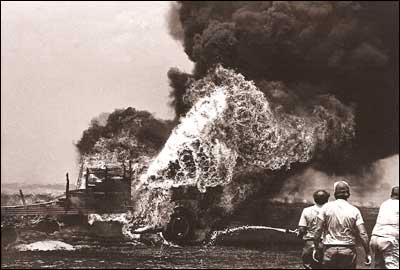
[June 30] One summer afternoon when I was reporting for the Larned Tiller and Toiler, I chased the firetrucks north of town to a fire in a wheat field. Stubble had caught fire under a farmer's truck, and the flames had swept across the freshly cut field and ignited another truck sitting with a partial load of wheat. When I got there, the firefighters were spraying the truck, but without enthusiasm. When I asked why, the chief said the gas tank was going to blow. So we waited, and the truck burned down to just about nothing. And then the saddle tanks got hot enough to boil the gas, which pushed outward so violently that it blew the lids off the long tank stems. The fumes flared out the pipes in a roar, blooming into a magnificent living orange flame. Every now and then we see or hear things that we immediately know will be unforgettable because they both frighten us and make us more alive too: a tornado, the long screech of tires that ends in a crunch, the first time we think we're going to drown. And an exploding wheat truck, flaming like the breath of the devil himself. I couldn't express my awe at the time, because losing the truck and wheat meant so much to the farmer. Drinking sensibly[June 29] Before I was a Boy Scout, I had a green plastic canteen (it came in a soldier set with a green plastic grenade), which meant I could camp in the back yard or walk for hours in Grandma's pasture without having to go back to the house for a drink. The water smelled of plastic, but the canteen was handy on my belt. When I became a Tenderfoot in Pawnee Rock's Troop 444, I got a real one-quart Scout canteen -- aluminum with a drab cloth cover -- from Penney's in Great Bend. Then I could camp at the river and survive like a true plainsman. When I became a 10-speed biker, I got plastic squirt bottles to protect me from dehydration and heat stroke in places far from a water faucet. When I became a grown-up hiker, I bought a water-filtering pump so I could refill my canteen just about anywhere, even in a swamp, without fear of catching an intestinal bug. I like having a bottle of water handy. I keep one in the car. But I draw the line at walking around with a bottle in my hand. Look closely the next time you're at a game or shopping or watching the TV news. It's amazing how many people won't walk down the block, pick Sonny up at the jail, or go to a meeting without their half-liter pacifier. I've seen far too many Associated Press photos of people posing for a picture with the president -- it's the biggest day of their year -- and they're gripping the Leader of the Free World in one hand and a bottle of Wal-Mart's finest in the other. I imagine such silliness doesn't play well in Pawnee Rock. After all, people who grow up on the plains learn to treat water with respect. The farmland salute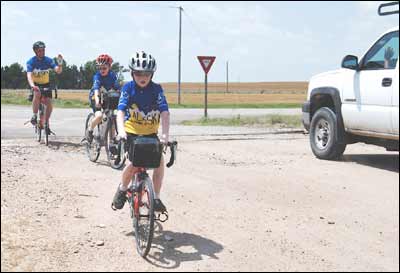
[June 28] One fact came to me as I faced the windshields of hundreds of cars, pickups, and semis this month while riding in Biking Across Kansas: Not everyone in the country wants to wave. With two youngsters in tow and eager to keep motorists from becoming annoyed at our vulnerable selves, I waved cheerily to almost everybody who passed us head-on or from behind. It was egotistical, I know, but I also imagined that there would be talk around supper tables: "I saw a whole bunch of them bike riders out by Susank this morning, and one of 'em waved to me." I hate to say it, but few other cyclists had the same thought. Although it was clear from our natural friendliness that some of us had grown up or lived west of U.S. 281, these 800 mostly city-dwelling bikers from Kansas and 26 other states generally waved among themselves and ignored the drivers whose countryside they were vacationing in. But I wasn't born in the big city, and I was glad to be home. The people in the Monte Carlos and Tauruses could have been my old neighbors from Barton County, or they knew my neighbors, or they knew people who might know somebody from Pawnee Rock. So I waved, a whole-handed wave on an extended left arm when possible, a lift of the left hand when steering required both palms to be close to the handlebars. Teenagers rarely waved back. Drivers on cellphones never waved, which is good because they didn't need any more hands off the wheel and, besides, drivers on cellphones are too self-absorbed to acknowledge others. Women waved back about half the time. From their high perches, truckers waved most frequently. (By the way, semi drivers were the most courteous motorists around the cyclists. I suspect that almost all drivers were gripping the wheel with both hands because they wanted to be ready in case of us wacky cyclists swerved into their path.) The drivers who made me smile were the old men. In sedans or in pickups, they waved the way men do around Pawnee Rock -- they raised an index finger off the steering wheel. If the driver felt generous, two fingers. Those just-enough waves said "you're home" as clearly as did the trill of the meadowlarks. Happy anniversary: Howard and Carole Bowman will celebrate their 50th wedding anniversary this extended weekend. Their kids are Robert, who lives in Great Bend, and David and Gay Beth, both of Lee's Summit, Mo. Howard and the former Carole Unruh were married in the New Jerusalem Church. Congratulations! (Full notice in the Tribune, June 17) Moving wheat in the 1950s[June 27] We published a photo of the Farmers Grain elevator on yesterday's homepage (now in the photo gallery), and that stirred up some sore-muscle memories in Leon Miller. After you read this, imagine yourself in a teenager's boots, covered in dust. Ready for a mason jar of ice water? Leon Miller's summer jobYour photo today reminded me of a time back in the early '50s when I got a job one summer driving a wheat truck in Dundee. So what's so great about that? Lots of people drive wheat trucks. Well, the story begins wherein there was a big wheeler dealer out of Salina, Kansas, named L.A. Morrison who had contracted with the USDA to store "government wheat" in storage facilities around the state of Kansas. There had become a big problem of surplus wheat in the plains states, enabling Morrison to make this deal to store the wheat for $0.15 a bushel per year, paid by the USDA. At that time there were several air bases left over from World War II with buildings sitting vacant, and Morrison made a deal with the communities to lease some of these (at a pittance) and store the wheat in them. My involvement started when I went to work for the L.A. Morrison Grain Company, showing up each morning about 6:00 a.m. at an elevator in Dundee, where there would be 15 or 20 boxcars loaded with wheat on the siding waiting to be unloaded. Another fellow and I would get inside the boxcar and grab hold of a pallet about 4 feet square that had a cable attached to the bottom of it. We would drag the pallet over the wheat toward the back of the boxcar and yell "PULL!" to an operator of the cable winch, and as we pushed the pallet down into the wheat the cable would drag the pallet, pulling wheat toward the open grain door, down into a pit where it was lifted into the storage bins of the elevator. I did this until about 9:00 a.m., then got into a truck, loaded it with wheat and drove about 5 miles over to the Great Bend Air Base. I would unload the truck in one of the warehouses and return to Dundee for a repeat performance. As I had a drivers license, I had the "privilege" of driving the truck, whereas my fellow workers were mostly Mexican laborers (who were legitimate) and did not have licenses. This routine continued until about 8:00 p.m., when we would stop driving (as the trucks had no headlights) and return to the elevator and unload boxcars up until 11:00 p.m. It was hard, backbreaking work but for someone who was young, it was a way to earn some money, although the pay was only $1.00 per hour with time and a half for overtime (after 40 hours). As the work week began at 12:01 a.m. Sunday morning, we would often be on overtime by Tuesday noon. I don't know if the process still exists today, but it was a character-building experience to a 19-year-old at the time. The brains of the family: Every now and then I'm reminded of why you should be nice to your sister. Here is a nicely written reason. The mower, the merrier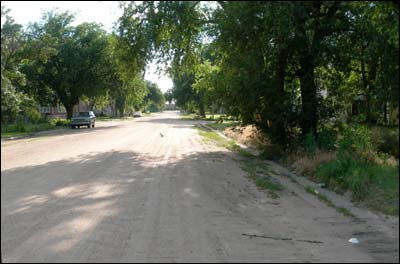
Some yards and trees along Pawnee Avenue yearn for a mower and clippers. [June 26] Every yard has a patch where the grass doesn't thrive. Maybe it doesn't get enough water, or perhaps the soil has too much clay or sand. The only thing that grows there is weeds. Tall weeds, thorns, vines, thistles -- Kansas' hardiest plants. But, being the practical Kansans we are, we mow that little patch. We don't always do it promptly, and sometimes it gets so bad that we have to push down on the bar in back to lift the front wheels and then we set the mower down atop the tall weeds and hope it doesn't choke the blade. What we're left with is two-inch-high stubble, which dries out as quickly as summer's wheat fields. Although it never was this way in your yard or mine, you and I both know yards where stubble is all there is -- or would be if those people would ever mow. Distant reaches of farmyards are that way, too. My grandparents' farm had some of those patches, especially on the fringe of the big driveway between the house and the barn where Grandpa and then Uncle Laramie parked the tractor and implements. We kids learned quickly that flip-flops and bare feet, while appropriate in May, were unsuitable for crossing that dusty expanse of punji sticks two months later. But now we're adults in sturdy shoes and we mow because we must, and we mow because we can. Weeds don't have a chance no matter what little corner of abused earth they sprout from. It's still fun to crank up the Briggs & Stratton and show the weeds who has dominion over the earth. Internet speed: Are you curious about how fast your connection to the Internet is? Go to speedmatters.org and click on the "test your speed" block. The organization's goal is to get everyone in the country on a high-speed connection. Kansas' median speed varies widely by county. According to the ZIP code search for Pawnee Rock, not enough people have taken the Speed Matters test locally to establish a median speed, although the rest of the county does well. Other countries, the site says, leave us all in the digital dust. Water under our feet: Stan Finger of the Wichita Eagle writes that the spring rain has recharged the state's aquifers, that the Cheyenne Bottoms area has an extra 11,000 acres of water, and that Wichita is pumping tens of millions of gallons of water back into the ground. Riders help preserve trail sites[June 25] St. John's Larry Mix, who runs the Santa Fe Trail Research Site, sends more information about the trail riders who passed through Pawnee Rock. Thanks, Larry. The photos you have on your site of the trail ride going through PR are the members and guests of the "Heart of the Flint Hills Chapter" of the Santa Fe Trail. They do this ride every year along different routes. The money they get from these rides help this chapter restore several of the historic site in the area where they are from, Old Stone Barn in Council Grove, Kansas, and the Wilmington School in Wilmington, Kansas, to name a couple. Photos are on our site and their web page. No big deal, just that I'm sure they would like to get credit for the hard work they do along their part of the SFT and the preservation of these historic sites. (Read more about the chapter at the Santa Fe Trail Research Site, and from a McPherson Sentinel article about this year's ride.) Trail riders visit Pawnee Rock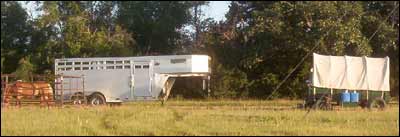
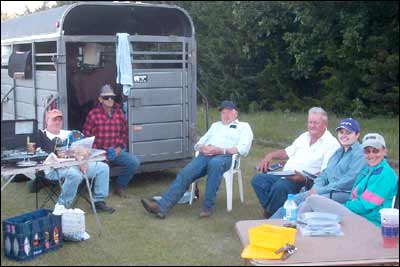
First photo: Santa Fe Trail Association wagons spend the evening along the school shelterbelt. Second photo: Among the riders were Carol Retzer, Kelly Miller, Dale Rickstrew, Leland Zerbe, Robbie Row, and Rick Antisel. Gary Trotnic made these photos. [June 25] Pawnee Rock has a long history of welcoming trail riders. The latest set came through earlier this month, and their visit was recorded for us by Gary Trotnic and Alita Felts: Riders camp at old schoolThe Santa Fe Trail Association came through Pawnee Rock June 8 for an overnight stopover down by the old school. We had to go down and visit with some of the folks making the trip. They told us on that day, there were approximately 15 that came in from Larned and approximately 6 more joined that day; the riders join the troupe whenever and whereever necessary. We talked to a very pleasant lady that seemed to be a leader of the drive/ride. Her name was Carol Retzer from Lyndon. In one photo we captured Carol, along with Kelly Miller, DMV, from Manhattan. Also in the photo was Dale Rickstrew of Wamego and Leland Zerbe of Council Grove, along with Ronnie Row of Strong City and Rick Antisel of Lyndon. Such a great bunch to be visiting our fair city! We took one photo of a horse trailer with two of the horses and it appears to have a chuck wagon sitting near by. Nancy Woodrow took pictures early the next morning of the entourage as they were leaving Pawnee Rock. 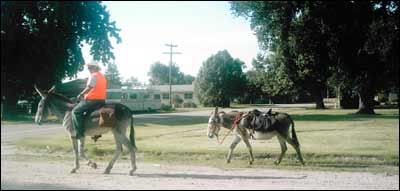
Nancy photographed these donkeys (or burros?) walking past the intersection of Cuniffe and Houck in Pawnee Rock. (Another of Nancy's photos is on the homepage.) Cheyenne Bottoms -- the inland sea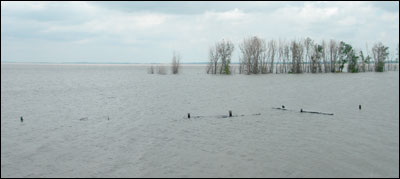
Cheyenne Bottoms Wildlife Area with more water than people gave it room for. This photo was made in June 2007. [June 24] A fellow who lives a little north of Barton County Community College had told me that 28 inches of rain had fallen around Great Bend during the spring storms. I scoffed. Who believes such a tall tale? And then I came puttering south on 156, right past the tornado-damaged shelterbelts, and there was a lake that spread out on both sides of the highway and across the horizon. Cheyenne Bottoms, is that you? We've all seen Cheyenne Bottoms Wildlife Area surge and ebb over the years. There were times when it was overly full, but generally the water stayed within the canals and pools, where migrating waterfowl fed and hunters fired from blinds. Cheyenne Bottoms is a central Kansas institution, although it rarely comes up in conversation. In fact, if you have lived in Pawnee Rock long enough, your family has gone to the bottoms for a Sunday evening picnic. Back in the summertimes before cable television and when people could survive without 24-hour air conditioning, families such as ours packed sandwiches and chicken and headed to the refuge, 20 miles away. The kids tossed a fishing line with a bobber and a nightcrawler into a canal -- and were enchanted with bullheads and crawdads -- and the more-talented adults baited up with chicken liver and no bobber. Killdeers and plovers picked bugs out of the mud, and swallows whipped overhead through clouds of mosquitoes. Pawnee Rock and Dundee folks had an extra incentive to visit Cheyenne Bottoms. River water that recently passed our towns was diverted north into Walnut Creek and then into another canal that led to the bottoms. We could always imagine that a stick we had tossed into the water at the Dundee Dam would float by on "our" water. Cheyenne Bottoms was an extravaganza: In tight-fisted Kansas, here was publicly owned and publicly accessible water for fishing and hunting. It was free and low-key. There was almost always water, maybe more and maybe less but always water. Then the public's water began to disappear, used up before it got to Great Bend by center pivots off to the west. Fortunately, publicity around the world is drawing attention to the needs and wonders of Cheyenne Bottoms, and that is helping preserve it. Now the bottoms, the accumulator of Barton County's overflow, are wet again in a legendary way, not because of smart water management but because of nightmarish storms. I suppose that's the way it is with geological features; you have to look at how they evolve over decades and centuries. The bottoms will go dry eventually, and they'll overflow again too. Just think: If these lowlands had always had this much water, homesteading posters hung on the East Coast and in Europe would have extolled the watery wonders of central Kansas and the nearest county seat would have been called Big Lake. A photo I like: No. 40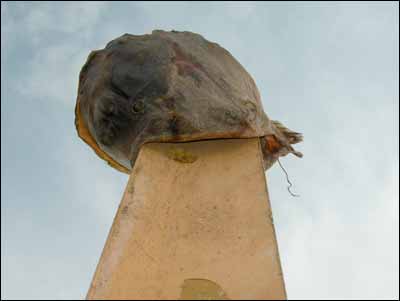
[June 23] Farmers like to hang things along their fencelines: tires, boots, the occasional rollerskate. One guy who runs a farm north of Hoisington brightened the landscape with this catfish head, stuffed whiskers down onto a 2x4. I can't tell whether it's a flathead, channel, or yellow cat. The good parts were eaten long ago, leaving only this foot-wide head. Movies on a summer night[June 22] Leon Miller, Pawnee Rock's architect in Dallas, saw yesterday's photo and item about improvements to the city park. He wrote: Back when I was a child the community had "free" movies on this site during the summer. As it was a large vacant lot, the city business community contracted with some fellow who had a traveling picture show and set up a large "screen," which resembled a big sheet, and attached it to the back of the old Lindas Lumber Company building, which was where the city fire department is now located. There were some benches that were "permanently" placed in front of the screen and when the sun went down the guy running the show would announce the sponsors (people who had paid him for this service), and then the show would start. These were no first-run movies but were free entertainment for the community. This went fine until one night the guy's projector caught on fire (the lamp in the projector got so hot the celluloid in the film burst into flames) and burnt up his equipment, his car and his business. I don't know how many communities had this service, but at a time when most folks couldn't afford to go to the movies this was an great evening out. Bumps in the night: I was shutting the linen closet door last night outside the boys' bedrooms in the half-light of the hallway. The hinge creaked -- really more of a croak -- and I felt the closet exhale as the door pushed air inward. I tried to be quiet, because Nik was already in the Land of Nod and Sam was on his way, but my footstep made the floor squeak under the carpet and I bumped the hamper. Do you remember, when you grew up in Pawnee Rock, how your parents moved gently through the house after lights-out? You were lying in bed, maybe in a room right under the roof or next to the bathroom, and you were tired from your busy summer day. In the hallway outside your room, footsteps came and went, and you heard quiet talk from the living room. You didn't want to see Mom or Dad. What you really wanted was some private time for your last-minute daydreams. You lay on the sheet, and the open window let in the shush of the breeze in the elms and the bang of the car door on the next block and you were at peace. It was reassuring, wasn't it, to know that the folks were out there, staying awake a little longer because grownups did that. You wanted your independence, but you still wanted to hear the gentle bumps in the night. Pride and fundraising in Pawnee Rock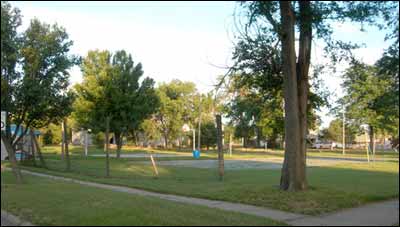
Pawnee Rock's tennis court could be repainted and have wind screens added to the north and south sides. [June 21]: City councilman Gary Trotnic sent this update about improvements to the city park downtown: I just thought I should let you know about the fundraiser that we had Sat. evening to help raise $ for the city park. We served hamburgers, hot dogs and brats, also had homemade ice cream and cakes. It was well received and had well over 80 people as we were constantly packed from 5:30 til 7 p.m. but served the public right up til 8 p.m. We raised $502. Monday morning we had more $ donated at city hall to the amount of $30. Anyone out there that still wants to donate to Pawnee Rock City Park fund can send it to the park fund at PO Box 218 here in PR, KS 67567. It will be greatly appreciated! To give you an idea of what we would like to do to improve the present park: • New metal roof on shelter house and restrooms All of this is going to cost approx. $1,200, just for materials. We have volunteers to do the work. Would like to get this accomplished as early this Summer as is possible as we have activities already planned for Sept. and such as that. If you or anyone that visits your site has any ideas &/or questions, please email me at gtrotnic@yahoo.com. 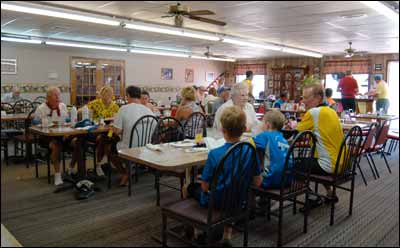
The boys and I chat with Peg Britton, the creator of KansasPrairie.net, over lunch at Made From Scratch in Wilson. Made From Scratch: In a recent entry I called a restaurant in Wilson the wrong name. I apologize and have corrected the earlier mention. Furthermore, I suggest that you go there and eat. Made From Scratch -- its real name -- is on Old U.S. 40, on the south side of the railroad tracks not far from the gas station and a block west of the museum. Peg Britton of Ellsworth met us there, and it was on her recommendation that I ordered a hamburger, which was big and delicious and came with potato chips right out of the fryer. The cherry pie was fresh from the oven, and when I go back I'll order the bierocks. Our waitress, Rose, paid a lot of attention to us despite the place being packed with cyclists and Wilson residents. In fact, we couldn't drink to the bottom of our glasses because someone was always there to make sure we were happy. If you're going to Lake Wilson anyway, go on a full stomach. To reach Made From Scratch from I-70, get off on the K-232 exit, go south briefly to Old 40, then go west a couple of blocks. Free parking, big enough for boats and RVs, is right across the street. K-232 is the road that'll take you directly north to the dam. Wilson is just over 70 miles north of Pawnee Rock: U.S. 56 to Great Bend, U.S. 281 to I-70 at Russell, and I-70 east to the K-232 exit. The lake is full and beautiful. (It's this kind of restaurant, Pawnee Rockers, that could be a destination also in Pawnee Rock. Word-of-mouth advertising delivers people from all over central Kansas to Wilson.)  John W. Nairn: John W. Nairn, born in 1924 to Blanche and John Nairn of Pawnee Rock, has died in Arroyo Grande, Calif. He married Marilyn Vassar in 1940 and moved to California in 1965. His brother Gene lives in Great Bend. (Obituary, June 13) Gano's name: Last week I mentioned a question about the pronunciation of our former elevator company's name: GA-no or Ga-NO. Leon Miller, whose dad, Cobb, ran the Mobil oil operation in town, wrote to say: "The years I grew up in Pawnee Rock, we always called it GA-no (1930s, 40s, & 50s)." Does anyone here remember calling it Ga-NO? I ran into a similar problem during my high school years. A friend from Great Bend talked about her elevator relatives as the BUN-ge family, and I had always thought of it as being pronounced "Bunj." So I know there's room for interpretation. 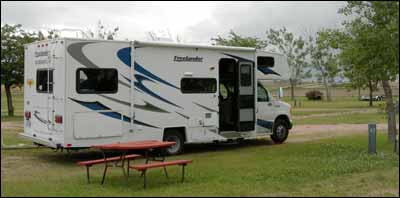
Morning in the campground on the edge of WaKeeney, a half-hour west of Hays along I-70. Off the road: We're back home from our Biking Across Kansas excursion and visit to Great Bend and Pawnee Rock. After leaving Pawnee Rock just before sunset Sunday evening, we parked the rental motorhome at the WaKeeney KOA campground (nice place) that night, then drove the next day to the KOA in Limon, Colorado. We got up by 5:30 Tuesday morning to pack the suitcases, drove the last 90 minutes to Commerce City to return the RV to Road Bear (nice company), and were ferried in Road Bear's van to Denver International Airport. Because we couldn't check our bikes and bags until 3 p.m., four hours before the flight, we sat there with our big pile until we could. After we checked in, we sat around for another three hours until we could sit on the plane for a five-hour flight northwest. We landed in Anchorage around 10:30 and got home just after midnight. Astronomically speaking, the longest day is today, the first day of summer. Speaking for the boys, however, I don't know how any day could be longer than the one we spent traveling. But now it's a new season. I wish all of you a pleasant summer. May your evenings be cool and your electric bills low. The beast and the beauty[June 19] During my quick stop in Pawnee Rock on Sunday, I was struck by two things: 1. The new elevator bin along the highway is all about efficiency. The cylinder looks strong and will hold a lot of grain, but it is utterly graceless. OK, maybe I'm being too rough. It's elegant in a minimalist way, like a roll of paper towels standing on end. And it does have a ring of decorative diamonds at the top. I saw a lot of these bins last week as I biked across the state. Now I appreciate even more the old steep-roofed frame buildings and the white-painted concrete elevators that are the soul of "old Kansas." The new bins, which seem to go unpainted, smack of factory farming. I hope our new friend grows a personality. 2. Pawnee Rock is a beautiful town in the closing hours of the day. The falling light brings out the green of watered yards and the trees, and it illuminates houses in subtle ways. If I could, I'd go out for a walk every day an hour before sunset. Kansas and my boys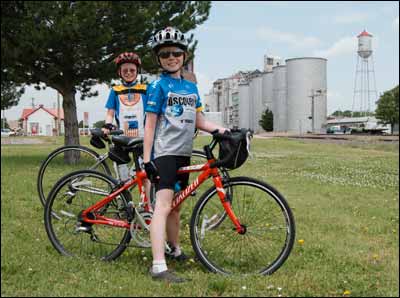 Sam and Nik in Wilson. (Photos by Margaret Unruh.) [June 18] It is hard for me to write about our Biking Across Kansas trip last week because nothing I can put on this page will adequately reflect the best thing I saw -- the development of our sons' characters. To entertain you, I could mention the cloudbursts, the 35-mph sidewinds, and the spills caused by sand adjoining shoulderless county roads. On the annual eight-day trip across 500 miles, five days were in hills. I also could tell you about the scenic roadkill, which is old hat to Kansans but new to Alaska-raised boys: toads, snakes, opossums, deer, tortoises, skunks, and raccoons upon which some tenderhearted rider had laid strands of Mardi Gras beads. You also might be interested in the restaurants and small-town architecture of the extreme reaches of Kansas. But here is what is most important to me: Nik, 9, and Sam, 11, pedaled every mile. They stood on their pedals and climbed every hill without stopping, they defeated every headwind, and they outlasted each inconvenience. Eighty percent of the adult riders also did those things. It might be argued, however, that fully formed adults could be expected to perform well. Nik was the youngest solo rider on the trip, probably the youngest one ever to ride the whole route. Other kids this year were as young as 7 but rode on the back of bikes built for two. Early on, Nik's feelings were hurt that he wasn't recognized for his presence, and he channeled that perceived insult into energy. As it had its insult, the ride also had its injuries. At midweek near Wells, east of Minneapolis, Nik crashed when his front wheel went off the road and into the sand. We rubbed grit out of his knee and Neosporin into it. A few miles down the road, Sam took a devastating spill riding downhill at 20 mph. He crawled off the asphalt into the tall grass, and I held my little boy for a while. Fifteen minutes later, scraped from chin to knee, he climbed back onto his silver bike. That was 40 miles into the day's ride, and when he finished the remaining 40 miles he was the bruised and bleeding center of attention among the riders and race directors (and a medic). The next day, he rode 79 miles without a complaint, and the day after that 75. During the week, some grownups told my wife, who was driving an RV from point to point along each day's route, that they thought the boys wouldn't last this day or that. My wife passed that along to the boys, who got more determined. The boys made their mark by passing adults on the big uphills near Lake Wilson, and by the end of the week grownups were cheering on "Lance Armstrong Jr." and shouting out "Team Alaska!" The adults may have been teasing, but the boys took the compliments seriously. We averaged 10 miles an hour, far slower than most riders, and some days we were on the road for 12 hours with eight hours of riding time. We were nearly the last people to finish each stage, beating only the folks who lingered too long in taverns and cafes partway through the ride or who stopped to smell the flowers or who gave up because they didn't have enough spring in their legs or heart to finish. 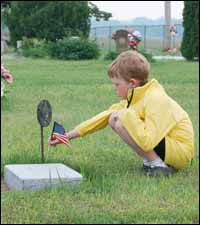 We didn't see much of the towns we passed through. Instead, we concentrated on getting from one town to the next without being run over as I begged, ordered, and talked them into trying to keep a steady pace along the white line. It wasn't all work, however. The boys had their pleasures. In La Crosse, they sprayed each other with a garden hose behind the Statue of Liberty. In Wilson, Sam stood on his toes at a restaurant window and watched a freight train go by. Near Minneapolis, they chased frogs. Until Sam's accident, they reveled in high-speed downhills. In Vermillion, late on Flag Day, the boys placed our small flags on veterans' graves. In Troy, they caught fireflies. They ate dozens of Popsicles. Despite the fact that we had had a map on the wall at home for several months before BAK, the boys had no way to comprehend in advance the vastness of Kansas or the bullheadedness of the devious wind. From the moment they mounted their bikes in Colorado until they walked down the concrete ramp into the Missouri River at Elwood, Sam and Nike rode because they loved to ride, and in the end that mattered more than all the difficulties. My wife and I organized a little ceremony after the boys got their wheels wet. We gathered on a ledge under the high double bridge and I presented them each with a medal inscribed with their names, the dates, and the deed. I half-expected Nik and Sam to give each other silly high-fives, but instead they just smiled and in their eyes I saw the beginning of an understanding. It's hard to estimate the long-term effects of the boys' riding across the Sunflower State. Sam and Nik have done so much more than I had at their age that I may not be capable of comprehending what they went through and how they feel. But I can say this: The boys will always know that when they were young, they earned their way across Kansas. Special praise and thanks must go to my wife, who drove our rented RV along the route. She provided several support stops each day -- 15 or 30 minutes of madness interspersed with hours of waiting. The delightful Peg Britton treated us to lunch Tuesday at Made From Scratch in Wilson, and she wrote such wonderful things about the boys that I'm almost embarrassed to link to her blog. We stopped to meet her gracious family on Sunday as we drove through Ellsworth on our way to Great Bend and Pawnee Rock. Aunt Cheryl and grandmother Anita drove up from Emporia and Arkansas just to talk to the boys for a few hours in Troy, the final overnight stop. The boys had looked forward all week to seeing them; I think they were slightly awed that someone would go to so much trouble for them. We wrapped up BAK at 9:30 a.m. Saturday and immediately headed south to the Kansas Speedway, just west of Kansas City. Even casual readers of Too Long in the Wind will know that the boys' interest in NASCAR is unrelenting. The boys had never been to a NASCAR track, so the promise of just driving into the parking lot was enough to pull them across the state. But I also secretly arranged to get them a private tour, which included a visit to the presidential skybox, the garage, the media center (they sat in the winner's chair and conducted a faux press conference), pit road, and Victory Lane. They got to sit in the driver's seat of a racing-school Fusion. Thank you, Julie Brown, Bob John, and the unidentified instructor from the 06 car, who interrupted his own family's visit to make our sons' day perfect. 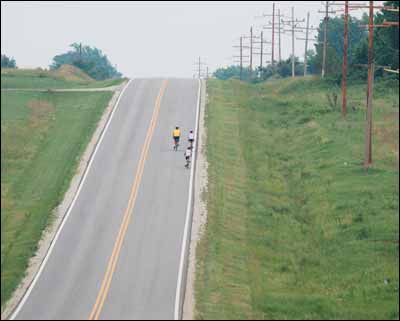 For Team Alaska, near Vermillion, riding across Kansas was a series of high points. A few hours in Pawnee Rock: I dropped into Pawnee Rock yesterday to see what remarkable changes had been made. The city looks greener and cleaner, I noted, and the new elevator bin has been topped off. We pulled up in front of Gary Trotnic and Alita Felts' house on Cunnife Avenue, and I had a nice chat with them about the town's progress and situation. I'll post photos and news from my visit in the coming days. After my few days off for Biking Across Kansas, it's good to be back with you. Ness City, Pawnee Rock, and Gano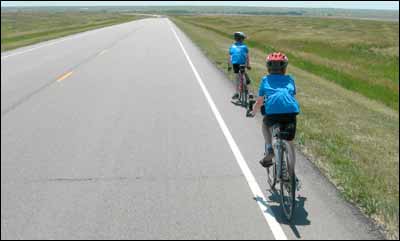
[June 11] After our Biking Across Kansas daily meeting last night, I grabbed Ness City's mayor and asked for help finding an RV dump station. On his way to look up a phone number, I asked what he did besides be mayor, and he said his family ran the town's elevators. I asked about one of Ness City's old elevators with a steeply pitched roof, saying I had seen several like it on our way across the state. That got us talking about elevators built in the 1920s by a company from Hutchinson associated with the Gano family. Well, I thought. Pawnee Rock has its hand in Ness City's elevators. The Gano family lived in Pawnee Rock before George Gano took his entrepreneurial expertise to Hutch and then across western Kansas. The mayor, who conceded that he was an elevator historian, mentioned John Gano; he and I weren't sure of the relationship between the builder and our George. The Gano elevator and coal shed in Pawnee Rock were torn down in, what, the 1980s, and the Gano offices were first on the west side of Centre Street and then on the eastern side. (See the Gano elevator in the Elevator Gallery.) Also, Mayor Gantz pronounced the name Ga-NO. I've heard it that way a few times, but more often it was GA-no. Does any of our readers know for sure? The mayor gave us first-class treatment. He drove Sam and me down to the RV park on the south end of town and then gave us a quick tour of the elevator operations. He had the air conditioning on in his pickup, which by itself almost qualified as my favorite part of the day. 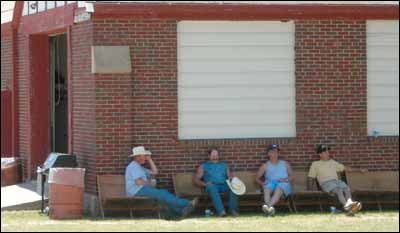
To get to Ness City in the first place, we rode the 55 or so miles from Scott City, pausing in Beeler for lunch. While the community's menfolk sat outside in wooden chairs, the women -- as you would expect -- ran the show in the old school/fire station. They dished up sloppy joes, fruit, and vanilla cake, which we ate under spreading elms. It was fun to ride a little on the dirt roads down to and back up from K-96. Biking Across Kansas is entering old South 50-6 League territory today. We will pass through Bazine and Otis on our way from Ness City to Hoisington. It's good to be back on the home soil. We crossed out of the high, flat plains into the broken hills west of Beeler. The waterways -- creeks and gullies -- now have trees along their banks, and farm-implement graveyards appear along the highway. The wheat looks good, and some could be ready to cut in a week if the weather stays dry. Sniffing out the scenery[June 10] Sam and Nik got a real whiff of western Kansas yesterday -- a pair of skunks and a half-mile-long feedlot. The two boys, 800 other BAK cyclists, and I left Tribune with a quarter tailwind of 15 mph at 8 a.m., which is far too early for a wind like that. But we sailed along, and the boys got lots of praise from older riders for doing well on their own. Other preteens are riding, too, but they're on tandems with their parents. It's easy to forget how easily one can get a sunburn even with SPF 50 lotion (I'm out of practice in applying it; I forgot to do one of my legs). Full-time Kansans may have year-round tans, but there are many out-of-staters wearing scarlet necks and knees today. The flat land along K-96 between Colorado and Scott City is pleasant. It makes me feel as if the whole world is stretched out in front of me. And to the north, the west,and the south. Perhaps it sounds foolish to exclaim over that version of "scenery," but when you live where the view is hemmed in by mountains and trees, you'd be glad to stand there out in the wide-open space and feel free. I explained to Nik as we rode side by side how I as a kid I pedaled out of Pawnee Rock on the asphalt and dirt roads. Now that he is abroad in that kind of countryside, on an asphalt road with wheat waving beyond the ditch, he listened as he has never listened before. A couple of days ago as we passed through some town, Nik thought he would yank my chain: "This looks a lot like Pawnee Rock," he said. "... Oh, yeah. All Kansas towns look the same." I'm pretty sure that after riding from Colorado and having spent days exploring Tribune and Scott City and Ness City as we move toward Barton County (Monday in Hoisington), Nik won't think Kansas is one big brown rectangle of cookie-cutter towns. Nik and Sam are having the hardest-working fun time of their lives. And they're not going to be intimidated by skunks and feedyards. They're tough kids, and they're getting to live out part of Kansas childhood. That sounds perfect to me, and pretty good to them. Biking with the Jackrabbits[June 9] Tribune is a nice town, and I'm not saying that just because it was named for a newspaper, Horace Greeley's New York Tribune, back in the booster days of early statehood. Our Biking Across Kansas entourage has set up camp at the high school, home of the Jackrabbits, and the community of about 760 people gave us a band concert, a spaghetti feed, Internet access, and all the friendly help we could ask for. There are signs along the highway, and several restaurants had special menus. BAK doubled the population of Tribune. That's a lot of faces to feed and plenty of opportunities for fundraising. Next up for overnight stays: Scott City, Ness City, and Hoisington. See you on the highway, and remember to wave. My alarm clock: The pheasant[June 8] I awoke this morning in Scott City to the music of pheasants and doves. And cattle trucks. It's good to be in Kansas in summer, camped under the big trees of the Pine Tree Campground. Today's the check-in day and unofficial start of Biking Across Kansas. This afternoon we'll drive to Tribune, 16 miles from the Colorado border, and get our badges and T-shirts. On Saturday, the big ride begins. (I'll update the site when possible over the next week. Not every town is likely to have wi-fi access.) As we drove in last evening down U.S. 83 from Colby, it occurred to me how Kansas was the opposite of Colorado, at least the famous parts of our western neighbor. Colorado is in relief -- the scenic parts stick up, but Kansas is in bas relief -- the scenery is formed by what was taken away by erosion. Monument Rocks stand tall, but only because the land fell away from around them, as happened with our own Pawnee Rock. The rocky gullies of the Smoky Hill River drainage are the stuff of movie scenery. And, of course, the fabled flatness of western Kansas is part of its charm, legendary because it is found so rarely in the world. Scott County is where it's obvious that Kansas used to be at the bottom of the inland sea. Limestone -- the remains of kazillions of little sea creatures and their enormous fishy cousins -- is the bedrock of the land. Tourists, however, don't flock to Scott County. Pam, whose family runs the campground, says the dozen or so drive-through slots are full only when the harvest crews work the area. That's a shame, because it's evidence that a lot of people are missing out on the windy plains and the herds of cattle and the big sky. I don't have to squint very hard at the sunset to imagine herds of bison eating their way across the land. The land-changing climate remains, changing the landscape too slowly for us to notice in our short lives. The blizzards, the summer heat, the gully washers that break the droughts, and the ever-present wind continue to move dirt and crack rock. In overpopulated eastern Kansas, the struggle of life has fallen to the level of people versus people. Here in western Kansas, it's still people versus a greater force. When the state has bad weather, this is where it's the baddest. This is the proving ground for the Sunflower State. And the people are nice, too. Wind comes sweeping 'cross the plain[June 7] Back in the middle 1970s, I photographed a dust storm moving in on Pawnee Rock -- a gray-brown fog that came with the south wind. The negatives show buildings being swallowed by the cloud. That was my second big duster. The first had come a few years earlier, moving up from the southwest like a blue curtain. Dad, who was driving me out to the cemetery at the time, stopped at the top of the hill above the Rock and told me about how his family had coped with the dust in the 1930s. I think we stayed long enough on the hill so that I could learn how suffocating a few minutes of the storm could be; a decade of it would be overwhelming. And then came yesterday, as I drove east from Denver on I-70. The south wind had been blowing in the 30s all morning at the airport and in town, but it picked up to the 50s around noon. I have never before seen city trees get such a workout. By the time I turned toward Limon, the eastern horizon was so dark and blurred that it looked like a thunderstorm, but it was nothing but topsoil. The wind started to push trucks across the road, and that's when I called it a day. At 6 p.m., the wind flipped to the north and blew the dust back where it came from. It was oppressive and grinding, and it whipped the hem off a lot of flags. I can see why some folks abandoned the droughty plains for California. The ones who stayed in places like Limon and Pawnee Rock, however, got the good stories to tell. Limon, looking back: When you're in Limon, do as I've done four times and make a point of visiting the Limon Heritage Museum and Railroad Park. Half the focus is on trains and farm implements, and the rest is on the cultures of the Indians and the settlers who replaced them. The museum and almost-a-century-old depot use vintage black-and-white photos extremely well. It's what I might dream of doing if PawneeRock.org were turned into a physical museum. This area has a big tie to Pawnee Rock. Eastern Colorado is known for its interest in Kit Carson, the explorer who, legend says, in 1823 shot his mule on Pawnee Rock thinking it was a Pawnee. There's Kit Carson County, along I-70 just west of Kansas, and the town of Kit Carson, to the south in Cheyenne County. Wildlife in Pawnee Rock[June 6] Virgil Smith, our hometown's former letter carrier with a camera, was quite a wildlife photographer when he lived in Pawnee Rock. He and Joan must have been pretty good with critters, too, judging by the squirrels and birds that visited their home. Several of Virgil's photos will appear on the homepage and in the gallery over the next few days. I got a kick out of them. Council chooses new mayor[June 5] There's news today from Pawnee Rock: a new mayor, a new city councilwoman, a new city clerk, a new city attorney, and energetic new plans for polishing our hometown. Mayor Mike Kirkman, who was elected April 3, has resigned for medical reasons. Tim Parret, who was elected to the council at the same time, was named mayor in Mike's place. (City government page) This correspondence came last night from Alita Felts and councilman Gary Trotnic: City Council meeting, June 4Just a quick note to bring you rather up-to-date with the goings on in Pawnee Rock. City Council met tonight and again we had a good attendance of approximately 30 citizens. With the resignation of our new Mayor there was a Notary Public from Great Bend present at the city coucil meeting to swear in the new Mayor Tim Parret. Also Ron Smith from Larned was sworn in as the new city attorney; Kathy Bohn was sworn in as our new city clerk. With Tim Parret moving up to the Mayor position there was a vacancy in the city council so Mayor Parret nominated Toni Stimatze to fill the vacancy. The council voted and approved so Toni was sworn in tonight also. The new city hall hours are 8 a.m. to noon Monday through Friday. Gary Trotnic discussed ideas to fix-up and improve the city park. The bathrooms are being brought back to where they can be used. He wants to put new fencing back of the tennis courts and paint the tennis courts. He wants to put new posts on the shelter over the picnic area, hoping later on to add a new roof to it also. The bathrooms will need a new coat of paint and new shingles on the roof. He doesn't want the money to come out of the city funds so fundraisers are being discussed beginning with a hamburger, brat, and hotdog feed on June the 18th, from 5 to 8 pm at the city depot. Gary Adams discussed the status of the city equipment. He also discussed the grading of the city streets; it will all take some time. He hopes to be able to get the weeds out of the streets and bring them back to normal. It was discussed that tomorrow evening at 7 p.m. will be an open city meeting with Allen Dinkel coming from Hoisington to talk with the City Council per the League of Kansas Municipalities. The public is invited to attend. Pawnee Rock is getting a new start and is looking Good! From the Land of the Cactus: Jared Smith, who appeared in the Arkansas River ice-skating photos yesterday (now in the Gallery), wrote: "After the harsh reality of going to work on a 107 degree Monday, coming home and seeing the photos you posted today made things all better (and cooler). Hope you are enjoying my Dad's old photos as much as we are." I am, Jared. Those are great shots and full of life. The Scouts' timeless advice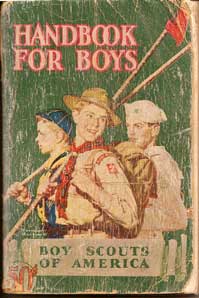
[June 4] These are words to the wise: • "Strange dogs are unknown quantities -- do not experiment." • "Don't loiter around a railroad yard, or play on or near the tracks. Read all warning signs at these localities and then obey them." Anyone can talk about being prepared, but unless you have an old Boy Scout Handbook for Boys, you'll never quite be ready for everything. I have a couple of handbooks, printed in 1943 and 1948, that Dad handed me when I joined Troop 444 in Pawnee Rock. At night I pored over the pages, absorbing details of camping, cooking, first aid, and woodsmanship that have stuck with me all these years and that I can still pull out of memory to annoy my family. 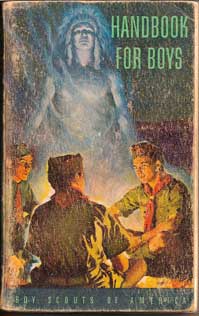 The handbooks were perfectly Scoutlike: straightforward, honest, and slightly formal. One of the nice things about the books is that they didn't strain to be all-inclusive; they were usable by all teens who wanted to learn to camp and live a well-ordered life. Of course, the masters of Scouting back then lived in a less cluttered world. They simply did not acknowledge large portions of the population (good luck finding a black kid or an Indian who didn't fall into the "noble savage" pigeonhole). But if you take the books at face value, they're a treasure. I like the idea of the Renaissance boys of the 1940s, diligently learning the species of cattle, understanding the range of the poplar, and knowing that they could make a fuzz stick to start a fire that much quicker. Across the country, perhaps around the world, a generation of boys had the same practical grounding in life. We do need people who know how to survive and thrive in the outdoors, and a book written by people grounded in the Great Depression and World War II was a good start for training. I bet I'm not the only camper who thought the following recipe was reasonable: Mutton or Lamb Chops (or Pork) These can be cooked in their own grease. Rub the hot pan (or piece of tin or flat stone) with the fat of the chop and then put in and salt as it begins to turn slightly red on top. Turn and repeat salting process. Continue turning until done to suit. The juice will butter your bread. The fireplace is made as follows: With the heel make a small trench in the direction the wind is blowing, or use two small parallel sticks as shown below. Use small dry twigs and small fire. 
Under the bridge[June 3] Back when the Arkansas River was one of our hometown's main attractions, a common gathering place was below the Pawnee Rock Bridge. (Photo in the gallery, page 29.) The bridge is only a couple of miles southeast of town, which made it the closest access point for fishing, picnicking, camping, and collecting rocks that had rolled down from Colorado. Carp and channel catfish lived here; we'd often see big carp -- schools of them -- swimming in the shallows. The catfish lurked under the banks, where cottonwood and willow roots provided protection. I imagine that every group that ever formed in Pawnee Rock had some kind of soiree here. The black circles of campfires -- half-burned driftwood, melted beer and pop cans, a smashed-flat can that had held Beanie-Weenies -- were common. The willows made good sticks for hotdogs and marshmallows. Boy Scouts camped on the sandbar in the middle and directly under the bridge. We always liked to come to the far side of the river, just to emphasize that we were far from home. Hunters came here, too, and target shooters. You didn't have to walk far to find a yellow casing or the glint of a .22 shell. Cottonwood trunks were undercut by the river undercut and then brought downstream to catch on the pilings. There was evidence of an earlier bridge, broken pilings rising from the sand. I never tired of coming to the bridge. By bike or by car, it was my place to visit when I had to go somewhere and figure out the world again. I could do that while tossing pebbles into the black muck or while bushwacking up and down stream. I had gotten to know the river pretty well in junior high when Rob Bowman and I had hunted carp with our bows and arrows. The new bridge is much stronger, but the old bridge will last longer in my heart. The rickety railing, the oil-sweating pilings, the driftwood caught in its embrace -- those make up the bridge to my youth. Bigger in Texas: I wrote yesterday about seeing Andre the Giant wrestle in Great Bend. Leon Miller, who lives where everything is bigger, has a bigger friend. Leon says he used to give an inservice program for knee replacement candidates at Baylor Medical Center in Dallas, where he lives. He got to know a patient named Calvin Lane, who is 7 feet 6 inches tall. Check out Calvin's site; Leon recommends the photo of Calvin and Shaquille O'Neal. Cousin Mary: I remember how much fun it was when you brought your scary stories and tales of Great Bend out to Grandma's farm, where we grandkids often slept over. When you were old enough to drive the family Falcon, you took us into Pawnee Rock one afternoon for snacks at Carris' grocery store. On the way back to the farm, you had to drive over one of the long piles of scrapings the road grader makes, and a pin in the clutch assembly was knocked loose. Fixing it was my first on-the-road car repair, and as you can tell I'm still proud of it. So I lift a glass of tea to you, Mary. Happy Birthday. A photo I like: No. 39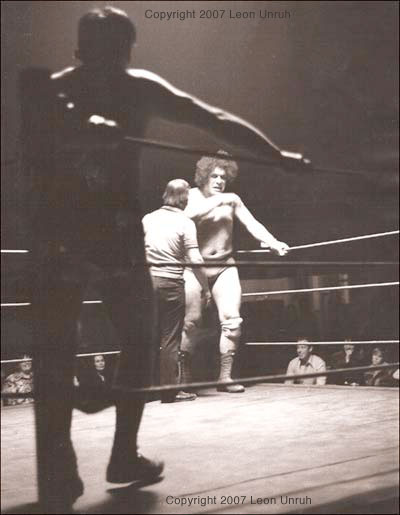
[June 2] Andre the Giant came from France to play the bad guy in wrestling matches in the big city and on television. While he was working his way up to the World Wrestling Foundation and a movie career, he paid his dues in such towns as Great Bend, which is where I found him. Andre stood at least 6 feet 10 inches high. Our photography club was meeting in the brick annex to the Great Bend City Auditorium one night when someone revealed that we could walk right into the auditorium. I think all the other club members turned up their noses and left, but I was fascinated by the crowd, by the lighting, and of course by Andre. Big Air Country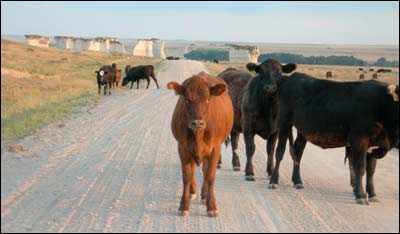
Cattle and a summer evening on the high plains. [June 1] I was writing back and forth with Peg Britton of Ellsworth about what it's going to be like this month during Biking Across Kansas. We agreed on a word: hot. That's OK. It's not what I'm used to anymore, but that's part of the attraction. Sometimes it feels good to be thoroughly warm. As Peg and I chatted, I got to thinking about what I'm looking forward to the most. Last summer, it was fresh fruit and vegetables. That probably won't be as much of an incentive this year, because I'll be moving along with 800 other vegetable chompers, and the first echelons of this plague of locusts will clean out every homegrown tomato between Tribune and Elwood long before I get there. This year, I'm most excited about the air. Free, clean, open air. The atmospheric lightness -- the dryness atop the rolling land -- makes me feel as if I'm on top of the world. The air of western Kansas isn't oppressive with humidity, nor does it carry the additional 3,000 feet worth of pressure you'll find along the Missouri border. You can sweat for hours and still not feel soiled, but after you do bathe and go outside, is there a cleaner feeling in the world? Western Kansas air can be a little dusty, I grant you, and anyone with a nose knows it's full of molecules of cow flop. Live out west, too, and you've got to love (or at least acknowledge) dry-land gardening. You know, a lot of outsiders roll their windows up, turn on the air conditioner, and drive like frightened cats through the western counties. They often say that they fear being bored, but I suspect that the plains are just too big for them. For me, though, it's just right. Big country, big sky, big air. |
Sell itAdvertise here to an audience that's already interested in Pawnee Rock: Or tell someone happy birthday. Advertise on PawneeRock.org. |
|
|